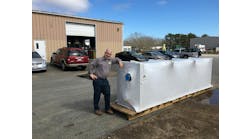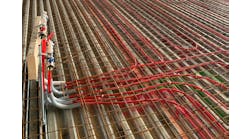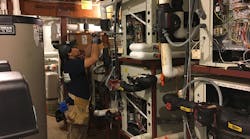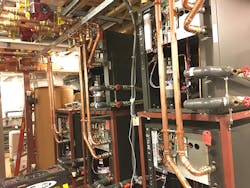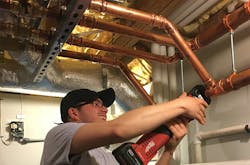EDGARTOWN, MA – Martha’s Vineyard has a reputation as the summertime playground of presidents and the east coast elite. It is also a tight-knit community with a set of shared values that come – at least in part -- from living on an island barely 20 miles long.
Some of those values include independence, frugality, and a deep respect for nature. All of which make the island a fertile market for anyone who designs and installs high-efficiency heating and cooling systems.
Brian Nelson, master plumber and owner of Nelson Mechanical Design, Inc., has been designing and installing just such systems since 2004 when he teamed up with his partner, master plumber Dave Sprague.
“Everything was very traditional,” Nelson says when recalling those early days. “It was oil boilers and baseboard heat. Things were a lot simpler back then.”
Nelson and Sprague created a niche market for themselves doing geothermal installations, usually combined with solar hot water systems. This was back before mini-splits were reliable, or even widely available. New technologies have helped change the market dramatically.
“Now solar electric on the roof and a heat pump water heater is actually more effective than doing solar hot water,” Nelson says. “And all these brand new inverter drive heat pumps are becoming almost as efficient as geothermal. So what’s exciting is we’ve been able to broaden our offering while staying dialed-in to the geothermal marketplace.”
The business has grown from just Nelson and Sprague to a 17-man operation. Nelson is amazed and thankful for all the success he’s had, and attributes a lot of it to the location. “The Vineyard is unusual,” he says. “If you offer people here good, better, best, most of them are going to say better and some are going to say, ‘Well, I don’t want better, I want the best.’ So we don’t have to compete on price, which is nice.”
A niche within their niche
Their years of experience have made Nelson Mechanical something of a niche within the geothermal energy niche: they are the go-to contractor when someone else’s system breaks down. Which, unfortunately, not all that uncommon an occurrence.
The clientele on Martha’s Vineyard is very green and very wealthy, and when a contractor is offered a high dollar amount to install a geothermal system they usually will, whether or not they have the technical ability. The result? A lot of systems that work acceptably for about a year, then begin to have problems.
'They built the whole house around the mechanical room... all the surfaces were finished.'
Case in point is one of Nelson Mechanical’s recent geothermal retrofits. At the point they were brought in three of the systems five, five-ton heat pumps had failed. Catastrophically.
“We got called in by the builder,” Nelson said. “The builder got beaten up by the owner, saying, ‘Hey, my cooling hasn’t worked for five years in a row! It’s been service call after service call.’” All this after paying top-dollar for a system that was supposed to be low-maintenance.
The house itself is about 8,000 sq. ft. with a lot of glass. It is also on the water, and often open to the air which created humidity issues. Yet still, at 25 tons the system should have had more than adequate capacity.
“So in this situation,” Nelson says, “it was trying to peel back the layers of the onion and really look at the homeowner’s perception versus the builder’s perception versus what we actually saw.”
After an involved troubleshooting process, Nelson finally came up with some answers. “If I could point to one thing,” he says, “they put on a crappy pressure gauge that failed. It failed five years ago and was stuck reading 20 lbs. and everyone just accepted that as gospel.”
Without correct pressure the circulators couldn’t properly circulate water throughout the system, the heat pumps would overheat until the high temperatures eventually killed them.
“The previous service guys kept looking at the fault codes and thought, well, maybe there’s a refrigerant problem, maybe there’s a problem with the heat pump itself and not looking at the whole picture,” Nelson says.
An invisible system
But diagnosing the problem was the easy part. The hard part was fixing it. Luckily the distribution system, the ductwork, was never an issue. However “They built the whole house around the mechanical room,” Nelson says, “and all the surfaces were finished.”
To get the old heat pumps out they had to be disassembled and carried up a narrow staircase. To get the new heat pumps – from ClimateMaster – in, Nelson Mechanical built a slide assembly to get them down to the mechanical room.
The new heat pumps had to go back into the original stands. Now the challenge became getting the new piping to work. How to get the new piping to flow correctly and still be able to service the system in the future?
“I had a talk with the insulator guy,” Nelson says, “and he said, the way you’ve got this drawn it’s going to be impossible to insulate… So I went home that night and thought about it and thought about it and finally, it came to me. We’ll go up and over. He’ll have more room, we’ll have more room.”
The result is an entire bank of Grundfos circulators over the mechanical room ceiling.
Under the old control set-up, three heat pumps would go on at a time and then switch right off, placing a lot of undue stress on the system. Nelson Mechanical solved the problem with staging controls from HBX, a Canadian company.
“They kind of bridge the gap where a lot of others don’t,” Nelson explains. “Everybody else had staging controls for four heat pumps, but nobody had them for five heat pumps. And fortunately HBX had expandable, add-on modules.”
The new display shows just what each heat pump is doing at any given time and how well the system is performing.
The system was wrapped up in June of this year, an $80,000 job. Yet Nelson admits they would not have made any money on the job if they had needed to solder all the copper piping connections. Most of the copper piping done for the retrofit was made using a press tool from Milwaukee.
And while Nelson is happy with the results and with the labor savings, as a person passionately concerned about the future of the trades in America he hopes the press tool doesn’t become too much of a crutch for the younger generation.
“I have had to do remedial classes with the kids in soldering,” Nelson says, “because when they do bump up on something they can’t press they’re kind of at a loss.”
The new system has finished an entire cooling season, and the new owners, after five years of misery and frustration, are very happy.
“It’s wonderful!” Nelson says. “We stopped by a couple of times and it’s just chugging along. It’s simple, robust and everything has been very stable. They hired us to make it invisible, and it’s been nice and invisible.”
